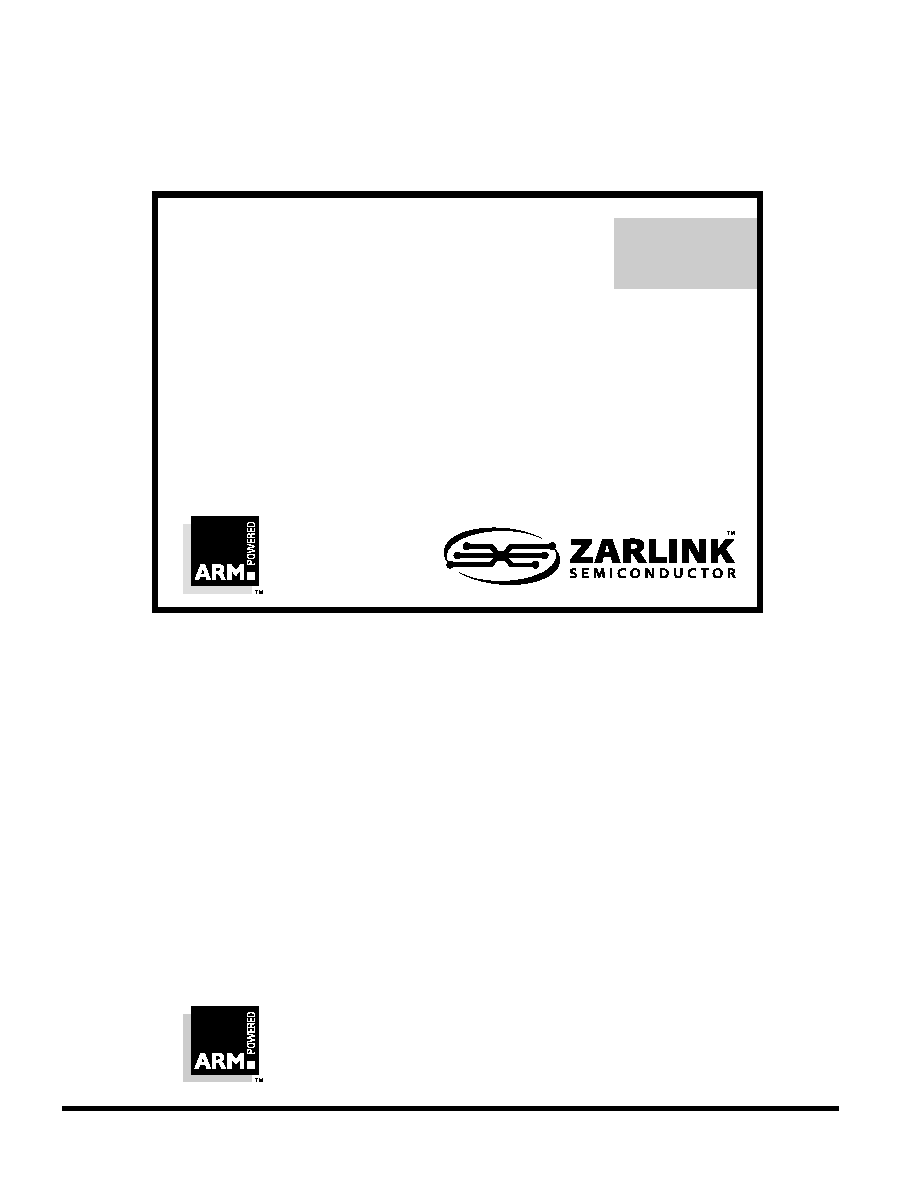 | –≠–ª–µ–∫—Ç—Ä–æ–Ω–Ω—ã–π –∫–æ–º–ø–æ–Ω–µ–Ω—Ç: P610ARM-B | –°–∫–∞—á–∞—Ç—å:  PDF PDF  ZIP ZIP |

ARM610
Data Sheet
Zarlink Part Number: P610ARM-B/KG/FPNR
Notes
1) The original P610ARM/KG/FPNR is obsolete
2) This datasheet includes the performance data previously supplied in supplement
MS4397 - Jan 1996
DS3554
ISSUE 3.2
October 2001
Manufactured under licence from Advanced RISC Machines Ltd
ARM and the ARM logo are trademarks of Advanced RISC Machines Ltd
© Advanced RISC Machines Ltd 1999
P610ARM-B/KW/FPNR

ARM610 Data Sheet
Preface-ii
Preface
The ARM610 is a general purpose 32-bit microprocessor with
4
kByte cache, write buffer and Memory
Management Unit (MMU) combined in a single chip. The ARM610 offers high level RISC performance yet
its fully static design ensures minimal power consumption, making it ideal for portable, low-cost systems.
The innovative MMU supports a conventional two-level page-table structure and a number of extensions
which make it ideal for embedded control, UNIX and Object Oriented systems. This results in a high
instruction throughput and impressive real-time interrupt response from a small and cost-effective chip.
Applications
The ARM610 is ideally suited to those applications requiring RISC performance from a compact, power
efficient processor. These include:
∑
Personal computer devices eg.PDAs
∑
High-performance real-time control systems
∑
Portable telecommunications
∑
Data communications equipment
∑
Consumer products
∑
Automotive
Feature Summary
∑
High performance RISC
25 MIPS sustained @ 33 MHz
(33 MIPS peak)
∑
Fast sub microsecond interrupt response
for real-time applications
∑
Memory Management Unit (MMU)
support for virtual memory systems
∑
Excellent high-level language support
∑
4kByte of instruction & data cache
∑
Big and Little Endian operating modes
∑
Write Buffer
enhancing performance
∑
IEEE 1149.1 Boundary Scan
∑
Fully static operation, low power consumption
ideal for power sensitive applications
∑
144 Thin Quad Flat Pack (TQFP) package
Address
Bus
JTAG
ARM6
Write
MMU
4Kbyte
Control
CPU
Buffer
Cache

ARM610 Data Sheet
Contents-1
1
Introduction
1-1
1.1
Introduction
1-2
1.2
Block Diagram
1-4
1.3
Functional Diagram
1-5
2
Signal Description
2-1
2.1
Signal Description
2-2
3
Programmer's Model
3-1
3.1
Introduction
3-2
3.2
Register Configuration
3-2
3.3
Operating Mode Selection
3-3
3.4
Registers
3-3
3.5
Exceptions
3-6
3.6
Reset
3-10
4
Instruction Set
4-1
4.1
Instruction Set Summary
4-2
4.2
The Condition Field
4-5
4.3
Branch and Branch with Link (B, BL)
4-7
4.4
Data Processing
4-9
4.5
PSR Transfer (MRS, MSR)
4-17
4.6
Multiply and Multiply-Accumulate (MUL, MLA)
4-22
4.7
Single Data Transfer (LDR, STR)
4-24
4.8
Halfword and Signed Data Transfer
4-30
4.9
Block Data Transfer (LDM, STM)
4-36
4.10
Single Data Swap (SWP)
4-43
4.11
Software Interrupt (SWI)
4-45
4.12
Coprocessor Data Operations (CDP)
4-47
Contents
TOC

Contents
ARM610 Data Sheet
Contents-2
4.13
Coprocessor Data Transfers (LDC, STC)
4-49
4.14
Coprocessor Register Transfers (MRC, MCR)
4-53
4.15
Undefined Instruction
4-55
4.16
Instruction Set Examples
4-56
5
Configuration
5-1
5.1
Configuration
5-2
5.2
Internal Coprocessor Instructions
5-2
5.3
Registers
5-2
6
Instruction and Data Cache (IDC)
6-1
6.1
Introduction
6-2
6.2
Cacheable Bit - C
6-2
6.3
Updateable Bit - U
6-2
6.4
IDC Operation
6-2
6.5
IDC Validity
6-3
6.6
Read-Lock-Write
6-3
6.7
IDC Enable/Disable and Reset
6-4
7
Write Buffer (WB)
7-1
7.1
Introduction
7-2
7.2
Bufferable Bit
7-2
7.3
Write Buffer Operation
7-2
8
Coprocessors
8-1
8.1
Overview
8-2
9
Memory Management Unit
9-1
9.1
Memory Management Unit (MMU)
9-2
9.2
MMU Program Accessible Registers
9-2
9.3
Address Translation
9-3
9.4
Translation Process
9-4
9.5
Level One Descriptor
9-5
9.6
Page Table Descriptor
9-5
9.7
Section Descriptor
9-6
9.8
Translating Section References
9-7
9.9
Level Two Descriptor
9-8
9.10
Translating Small Page References
9-9
9.11
Translating Large Page References
9-10
9.12
MMU Faults and CPU Aborts
9-11
9.13
Fault Address and Fault Status Registers (FAR and FSR)
9-11
9.14
Domain Access Control
9-13
9.15
Fault Checking Sequence
9-14
9.16
External Aborts
9-16
9.17
Interaction of the MMU, IDC and Write Buffer
9-17
9.18
Effect of Reset
9-18
10
Bus interface
10-1
10.1
Introduction
10-2
10.2
ARM610 Cycle Speed
10-2

Contents
ARM610 Data Sheet
Contents-3
10.3
Cycle Types
10-2
10.4
Memory Access
10-2
10.5
Read/Write
10-3
10.6
Byte/Word
10-3
10.7
Maximum Sequential Length
10-3
10.8
Memory Access Types
10-5
10.9
ARM610 Cycle Type Summary
10-9
11
Boundary-Scan Test Interface
11-1
11.1
Introduction
11-2
11.2
Overview
11-2
11.3
Reset
11-3
11.4
Pullup Resistors
11-3
11.5
Instruction Register
11-3
11.6
Public Instructions
11-3
11.7
Test Data Registers
11-7
11.8
Boundary-Scan Interface Signals
11-10
12
DC Parameters
12-1
12.1
Absolute Maximum Ratings
12-2
12.2
DC Operating Conditions
12-2
12.3
DC Characteristics
12-3
13
AC Parameters
13-1
13.1
Test Conditions
13-2
13.2
Relationship between FCLK and MCLK
13-2
13.3
Main Bus Signals
13-4
14
Physical details
14-1
14.1
Physical Details
14-2
15
Pinout
15-1
15.1
Pinout
15-2
Backward Compatibility
A-1
Backward Compatibility
A-2




